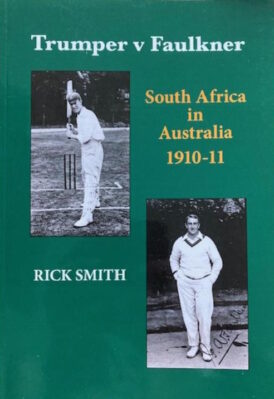Trumper v Faulkner
Martin Chandler |Published: 2024
Pages: 133
Author: Smith, Rick
Publisher: Apple Books
Rating: 3.5 stars

There are still a few cricket tours that have not been the subject of books, but one less after the publication of Trumper v Faulkner, Rick Smith’s account of the first visit of a South African side to Australia. Fifteen South African cricketers arrived in Adelaide at the beginning of November 1910, and they travelled round South Australia, New South Wales, Victoria, Queensland and Tasmania for the next four and a half months.
There were five Test matches for the tourists, and ten other First Class matches, five of them before the first of the Tests. The acclimatisation was essential for men who had never played in Australia before and who, save those who had visited England in the past, had never previously played on turf wickets.
At the time there were many in Australia who feared that the series would be a dreadful mismatch, and that the home side would romp home. It was true that the last two England sides to visit South Africa had returned defeated, but those teams were by no means representative of the full strength of England, and the home side had their familiar matting wickets to play on.
In the event the Australians did win the series easily enough, but the South Africans put up a decent fight. They got themselves into an excellent position in the second Test, only to then fall 89 runs short in pursuit of a target of only 170. They won the third Test however, and if they didn’t trouble the Australians unduly in the final two Tests all in all they gave a good account of themselves over the series and, most importantly, attracted enough Australians through the gates to ensure the tour did not make a loss.
As Rick Smith’s title makes clear the outstanding players of the series were the legendary Victor Trumper (average 94.42) and Aubrey Faulkner (average 73.20). The difference between the two sides was that three other Australian batsmen, Warren Bardsley, Clem Hill and Warwick Armstrong, all averaged more than 50, whereas only two other South Africans, Billy Zulch and Dave Nourse averaged more than 30.
With the ball Australia’s left arm seamer Bill Whitty took 37 wickets at 17.08, and in addition leg spinner Ranji Hordern and paceman Tibby Cotter performed well. The South African attack was centred around it’s famed googly bowlers, but only Reggie Schwarz with 25 wickets at 26.04 enjoyed much success. All of Bert Vogler, Sid Pegler and Buck Llewellyn were largely ineffective as Faulkner, at his best a top class right arm wrist spinner. Faulkner did bowl a lot of overs, and he had took ten wickets to show for them, but he paid 51.40 runs for each of them.
The story of the series can, more than a century on, only be told through the lens of contemporary writing. There were no books published on the series, and there was not even a brochure. Charlie Macartney, as yet far from the player he was to become did later write an autobiography twenty years after the event, as did Hordern, but neither of them dwell on the series at length.
Sometimes diaries or scrapbooks from players come into historians’ hands but, sadly, not on this occasion. Smith did however have the very considerable body of research compiled by his great friend the late Brian Bassano and that, coupled with contemporary press reports, has enabled him to put together an engrossing account of what was, by definition, a ground breaking tour.
I do of course appreciate that interest in cricket tours that took place over a century ago is not such that retrospective accounts of them are ever going to be bestsellers, but t would still expect this one, produced in a signed and numbered limited edition of just 100 copies, to sell out very quickly. Roger Page is the man to contact for those interested in purchasing.






Leave a comment